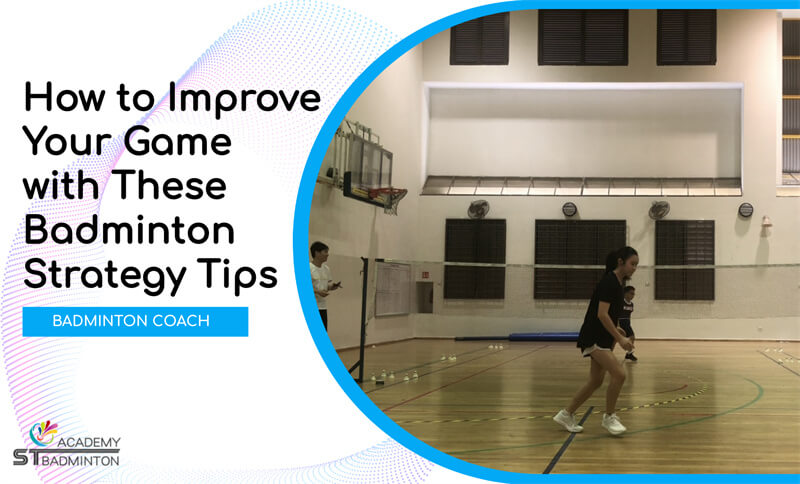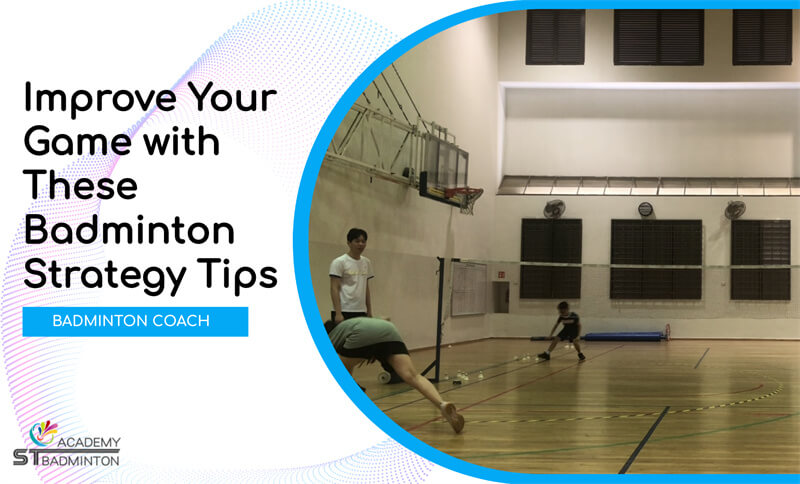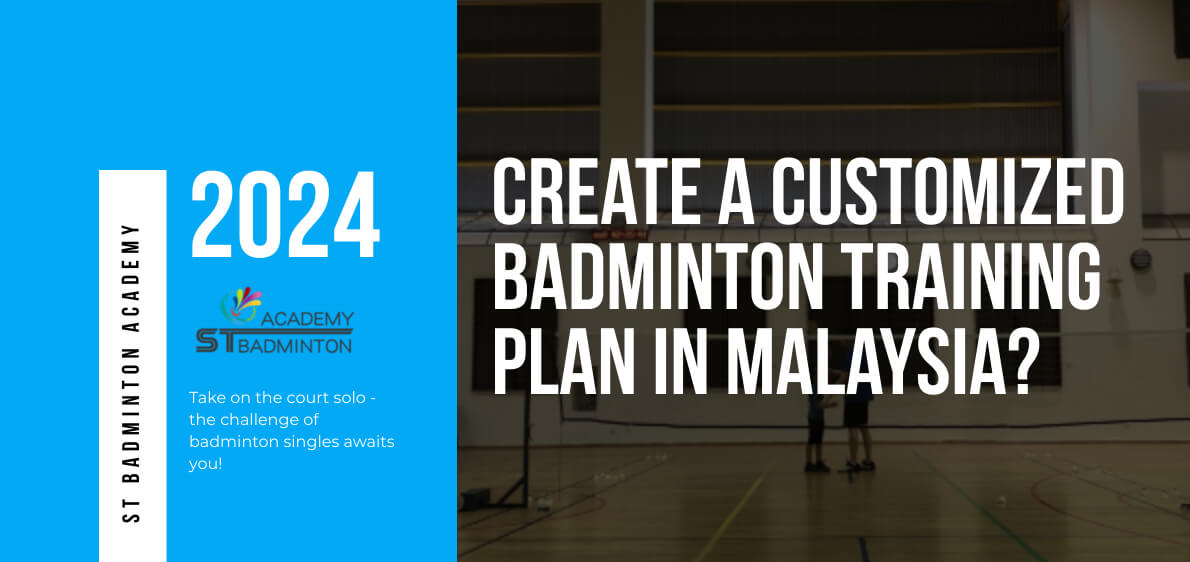Welcome to the ST Badminton Academy in Malaysia KL! Are you a badminton enthusiast looking for ways to drastically improve your game? If so, then look no further! This article offers practical advice on how to become a more successful singles player. From improving technique to developing mental strategies that will give you the edge over opponents, these tips are guaranteed to help you dominate the court in no time. Keep reading and start making strides toward becoming an unbeatable opponent!
It’s easy enough for anyone to pick up but hard enough to keep even experienced players coming back for more. With its fast-paced nature, it can be difficult at times to stay ahead of the competition – especially if playing singles matches. That’s why we’ve put together this guide full of useful tips and tricks designed specifically with singles play in mind. Read on and find out what steps you should take next to get a competitive edge!
Whether you’re an adult or a casual player, there are always areas where improvements can be made when it comes to badminton strategy. Learning new techniques and honing existing ones will make sure that you have all the skills necessary for success on the court – from mastering footwork patterns, perfecting serves, and learning effective defense tactics. Get ready for some serious improvement as we delve into everything from basic fundamentals to advanced strategies that will ensure victory every time!
Basics Of Badminton
Badminton: the sport that requires no skill, right? Wrong! It takes practice and knowledge to become an elite badminton player. So let’s start with the basics of the game.
The scoring system in badminton is simple; whoever reaches 21 points first wins a set and two sets win a match. This means you need to be constantly aware of your score as well as your opponent’s score – it can change at any moment. There are four types of shuttlecocks used in badminton, feather shuttles, plastic shuttles, normal-speed shuttles, and high-speed shuttles. You must choose wisely which type best fits your playing style or strategy for each match.
Now for equipment setup; there must be a net separating both sides of the court along with poles to keep it raised off the ground at all times. On either side of the court, there should also be posts where players will stand during gameplay (known as ‘service boxes’). The dimensions for these courts vary depending on if you’re playing singles or doubles but they usually range from 13-17 meters long and 5-6 meters wide.
So now that we have discussed some basic rules and guidelines needed to understand badminton better, why not take what you’ve learned here today out onto the court? Not only will this help you improve your skillset but it will also give you a chance to show off those fancy footwork moves too!
Essential Equipment & Gear
Now that you know the basics of badminton, it’s time to equip yourself with essential gear and equipment. A good quality badminton racket is key for a great game. It should be lightweight with an ergonomic handle so you can easily move around the court. Badminton shoes are also important – look for ones that provide traction and cushioning to help prevent injury while playing. Don’t forget about the shuttlecock! Make sure your shuttlecock is made from good-quality feathers and has accurate weight distribution. Finally, make sure you have a badminton bag to store all your equipment in one place as well as a net to practice on at home or when playing doubles matches. With these items, you’ll be ready to take your game up a notch and dominate the court!
Footwork & Movement Techniques
Good footwork and movement techniques are essential for success in badminton singles. Proper timing, balance, swiftness, and agility on the court can help you dominate the game. To ensure that your badminton footwork is up to par, here are a few basic tips:
First of all, it’s important to stay light on your feet during play. When you move around the court, try not to make heavy contact with the ground as this will slow down your reaction time and reduce mobility. You should also practice shuffling back and forth between shots so that you remain ready at all times. Badminton footwork relies heavily on quick changes of direction; therefore, be sure to work on changing directions quickly while keeping balance throughout the motion.
When playing singles matches, proper positioning is key to controlling space on the court. Take advantage of small opportunities by being prepared to move into open spaces quickly using short steps and fast reflexes. Additionally, when recovering from long shots or rallies where both players have moved away from their original position, use large strides instead of many small ones to get back faster without wasting energy or momentum.
By regularly practicing these simple but effective techniques for badminton footwork and movement, your performance in singles games will improve drastically! With improved speed and agility, you’ll be able to outmaneuver opponents more effectively and gain an edge over them every time!
Gripping The Racket For Maximum Power
Once you have mastered the footwork and movement techniques, it is time to move on to gripping the racket for maximum power. When playing badminton singles, having a strong grip technique can be especially beneficial. To ensure that your power grip is correct, there are several key points to keep in mind.
The first step is finding a grip style that works best for you. This could mean using an Eastern forehand or backhand grip, continental grips, or any other type of suitable grip style. Once you find what works best for you, practice regularly to perfect it. Make sure not to squeeze too tightly on the handle as this will make your shots less accurate and powerful. A relaxed but firm grip should give your swing more control while still allowing enough flexibility when hitting shots across the court.
The second important point about badminton racket grips is ensuring that they remain consistent throughout the game. If your grip changes during a match, then so too will your accuracy and power output when hitting shots. It’s important to maintain the same hold no matter how much pressure or stress comes into play to maximize both the accuracy and strength of each shot taken during play.
By practicing these two key principles – finding a suitable grip style and maintaining consistency – players can improve their badminton skills drastically during singles matches. With improved power and accuracy from a good racket grip technique, winning games becomes easier than ever before!
Developing A Strong Serve
Having a strong serve is essential in badminton singles. Having the ability to deliver an accurate, powerful serve can give you a huge advantage over your opponent. Developing such a service requires practice and focus on the proper execution of techniques.
Start by mastering the basics: Make sure your feet are positioned correctly for balance; hold the racket just above waist level with both hands; keep your back straight when tossing the shuttlecock into the air; then accelerate and follow through towards the direction where you wish to hit it. With each repetition, get comfortable with these steps while also increasing power and accuracy.
To increase serving power, pay attention to how much energy you put into your swing every time. The more force behind it, the faster and further it will go. However, don’t sacrifice accuracy for power – try striking slightly lower on the strings of your racket to create greater spin so that they land within court boundaries without fail. Frequent practice sessions focusing on improving serves will help build this muscle memory until it becomes second nature during matches!
Return Techniques For Singles Play
Now that you have a strong serve, it’s time to focus on returning shots in singles play. Returning is an important part of dominating the court during badminton singles matches. Here are some techniques and tips for effective returns:
- Keep your eye on the shuttle at all times. This will help you anticipate where it’s going so you can be better prepared to hit it back.
- Use footwork to get into position. Focus on getting low and moving quickly between shots rather than staying stationary with sluggish movements. Be sure to move around the court to gain an advantage over your opponent.
- Utilize different types of returns based on what type of shot you’re receiving. If your opponent is hitting a clear or drop shot, use one of these techniques: netting (hitting close to the net), lifting (hitting high above the net), or driving (hitting a flat shot). For smashes, drive them back with power and accuracy as this will make your opponent scramble for their return shot.
These tips should give you a good starting point when it comes to improving your returning skills in badminton singles play. With practice and dedication, you’ll soon become a master at controlling rallies and outplaying opponents!
Placement Strategies For Singles Play
Just like a chess master’s strategy, badminton singles is about placement. Where you place yourself and your shots on the court can mean the difference between winning and losing. In order to dominate the court in singles badminton, here are some key tips for strategic positioning:
| Placement | Purpose |
|---|---|
| Net Play | Aggressively challenging opponent at the net |
| Court Positioning | Moving around to keep the opponent guessing |
| Strategic Shots | Choosing what shot will be most effective given the circumstance |
Net play requires aggressive movement towards the front of the court, engaging your opponent at their weakest point – near the net. If done correctly, this type of placement can quickly put an end to rallies or even entire points. When playing away from the net, it’s important to move around as much as possible; if your opponent starts predicting where you’ll go next, they won’t leave themselves open for attack. Finally, choosing which shots will be most effective based on where you’ve placed yourself is essential for success in singles matches. Utilizing drop shots when close to the net or lobs when far back can confuse opponents and force them into making mistakes that ultimately lead to victory.
Whether by keeping your opposition off balance with changeable court positioning techniques or landing cleverly-timed strategic shots, mastering these placement strategies will help propel your game up to a higher level. So don’t hesitate – to start implementing these tips today and make your mark on badminton singles!
Rules And Regulations Of Competitive Badminton
Playing competitive badminton requires understanding the rules and regulations that govern play. These rules must be followed in tournaments, as well as during casual games. The court size for singles matches is 13.4 meters long by 5.18 meters wide, while doubles courts measure 17.68 meters long and 6.10 meters wide. Additionally, each end of the court is divided into halves with a net running across them at 1.55 meters high for men’s matches and 1.524 meters high for women’s matches.
When playing competitively, players must also adhere to code conduct guidelines established by the Badminton World Federation (BWF). This includes requirements such as wearing proper attire, respecting opponents, being courteous to line judges and referees, and avoiding any unsportsmanlike behavior or language on the court. Players should also be aware of all scoring rules before beginning matchplay; scores are only awarded when one team fails to return the shuttlecock within its boundaries or if their opponent commits a fault due to contact with the shuttlecock outside of their designated area on the court.
Finally, it’s important to understand how tournament play works for both singles and doubles categories before participating in a competition. Singles matches consist of three games played up 21 points apiece (with increments of two) and can have either five-point tiebreakers or sudden death deuce points depending on tournament regulations; doubles competitions usually involve best-of-three games with 15 point increments per game but may feature different formats based upon event organizers’ preferences or player rankings. Understanding these rules will ensure an enjoyable experience when competing in badminton events around the world!
Mental Tips To Outplay Your Opponent
Now that you have mastered the rules and regulations of competitive badminton, it’s time to take your game to the next level. With the right mental techniques, you can outwit opponents and dominate on the court. From mastering psychological strategies to playing mind games, these tips will help you stay ahead in a match.
Mental toughness is key when competing in any sport – especially badminton. Win an intense rally or close match requires strong focus as well as resilience during adversity. You must maintain concentration even with distractions such as loud cheering from spectators at tournaments or noisy surroundings in general. By training yourself mentally for these scenarios beforehand, you can gain an edge over your opponent.
Game planning is another important component of successful badminton singles play. This includes analyzing their strengths and weaknesses so that you can exploit them accordingly by attacking their backhand side more often or using drop shots strategically against someone who tends to be slow on net retrieval. Additionally, understanding how they react under pressure gives you an insight into which parts of their game are vulnerable and where to target your attacks.
These mental tactics not only give you a better chance of winning but offer invaluable insights into the art of outwitting opponents and controlling matches through manipulation of psychology rather than brute force alone. While physical fitness plays an important role in all sports activities, there’s no denying the importance of sharpening your mental acumen if you want to reach top levels in badminton singles competitions.
Training Regimen To Improve Performance
Developing a specific badminton training routine is essential for improving performance on the court. This should include drills and exercises that focus on skill development, as well as physical conditioning to build strength and endurance. A successful training plan will improve your agility, speed, coordination, and overall technique to become more competitive in singles matches.
To begin with, create a practice schedule that includes time dedicated to both technical skills and fitness workouts. For example, you could concentrate one day of practice exclusively on serving or forehand shots. Spend other days working on footwork drills such as jumping rope or practicing shuttle runs around the court boundaries. When it comes to fitness training, try activities like running intervals or circuit training focused on muscle building and cardiovascular health.
Regularly incorporating these elements into your practice sessions can help bring your game up to the next level. Additionally, be sure to give yourself rest days throughout the week so you have adequate recovery time before playing again. Through diligent effort and dedication to this regimen you’ll be able to achieve greater success when competing in badminton singles matches.
Frequently Asked Questions

What Is The Best Way To Warm Up Before A Badminton Match?
A badminton warm-up is like a key that unlocks the door to success on the court. Just as a key needs preparation and maintenance for it to unlock the door, so do athletes need to have proper pre-match preparations before playing their games. Properly warming up before a badminton match can make all the difference between victory and defeat.
Before starting any badminton warm-up routine, one should always start by stretching. This helps loosen muscles and get them ready for more intense activities such as running or jumping. Stretches should focus on major muscle groups including arms, legs, back, shoulders, and chest. After completing a light stretching routine, athletes can move on to other pre-match exercises such as shadow swings or short sprints. Shadow swinging helps hone players’ skills while also getting them warmed up at the same time; whereas short sprints help increase blood flow throughout the body which leads to increased agility during gameplay.
Finally, mental preparation is just as important as physical when it comes to playing badminton well. It is essential that players take some time to clear their minds and visualize what they want from their performance during the upcoming match. Visualization has been proven to be an effective technique to improve performance across many sports and its effectiveness shouldn’t be underestimated when preparing for a match of badminton either!
In summary, having an appropriate warm-up routine before each badminton match will go a long way toward helping you achieve your desired outcome of winning every game! Preparation includes both physical elements such as stretching and exercise routines along with mental aspects such as visualization techniques. All these combined together create the perfect storm of conditions necessary for success on the court!
What Are Some Tips For Playing Badminton In Windy Conditions?
Playing badminton in windy conditions can be a challenge, but it is still possible to win. Having the right strategy and tips for playing in windy weather can make all the difference. This article will provide some helpful advice for playing badminton in these types of conditions.
When playing badminton outdoors, always pay attention to the current weather conditions. Windy days are particularly tricky because gusts of wind can knock your shuttlecock off course or interfere with your shots. To ensure that you don’t get caught off guard by sudden gusts, try positioning yourself closer to the net than usual so that you have more time to react. Additionally, stay low and use short strokes when serving and hitting as this reduces the amount of air resistance on your shots and gives them more power against strong winds.
In terms of strategy, one key tip is to play defensive when up against stronger winds. Focus on keeping your opponent’s shots contained by using soft blocks rather than attempting big smashes which may end up being blown away from the court due to high winds. Also consider making modifications to your grip depending on how powerful the wind is: opt for a firmer grip if there’s less air resistance or switch to a loose grip if it’s too strong causing instability with each shot.
By following these simple strategies and tips, players should be able to adjust their game according to changing weather conditions during a match and maximize their winning chances even in challenging windy conditions.
Are There Any Specific Exercises To Promote Better Reaction Time During A Badminton Match?
Are there any specific exercises to promote better reaction time during a badminton match? This is an important question for those looking to take their game to the next level. Having quick reactions can be the difference between winning and losing in a competitive match, so it’s essential that players understand how to improve their reaction times.
According to our badminton coach, there are several exercises and drills designed specifically to help badminton players with their reactions on the court. These include:
-Improving footwork speed through side shuffling practice drills
-Practicing reflex shots such as fast drop shots or angle returns
-Developing agility by doing cone drills or jumps over hurdles
Incorporating these exercises into your regular practice routine will not only provide physical benefits but also mental ones; having more confidence in your ability to react quickly will give you an edge when competing against opponents. It’ll enable you to anticipate where the shuttlecock is going before it even gets there, giving you valuable seconds to prepare for each shot. Additionally, working on improving your badminton reaction time helps make up for other deficiencies in technique – if you can respond quicker than your opponent, then they won’t have enough time to get into position or set themselves properly.
Ultimately, developing better reaction times requires dedication and hard work; however, with consistent effort and commitment, anyone can significantly enhance their performance on the court. By gradually incorporating these reactive drills into your training sessions, you’ll start seeing improvements in no time!
How Can I Improve My Footwork Technique?
Good footwork is essential to playing a successful game of badminton. Improving your badminton footwork technique can help you become an even better player. So how can you improve your footwork?
One way to improve your footwork technique is to practice drills that focus on quick and precise movement. Footwork drills such as shuttle runs, jumping jacks, or side lunges are great for increasing agility and reaction time while also helping with coordination and balance. Additionally, practicing strokes like drop shots or net shots will help sharpen the accuracy of your movements. It’s important to isolate key elements of each stroke so you can move quickly and efficiently around the court.
By incorporating these drills into your training regimen, you’ll be able to hone in on specific techniques that will help elevate your badminton performance. Make sure to mix up the exercises every now and then so it doesn’t get too repetitive – this keeps things interesting and helps maintain motivation levels! With consistent practice, you’ll soon see improved results in terms of speed, accuracy, and overall confidence during matches.
So if you’re looking for ways to take your badminton skills to the next level, working on improving your footwork technique is certainly a great place to start. Take advantage of all the resources available (such as online tutorials) and don’t forget about having fun along the way!
What Is The Best Way To Practice My Badminton Serve?
The badminton serve is one of the most important shots in a match. It can be used to gain an advantage or even win you the point outright, so it’s essential that players practice their technique regularly. But how do you make sure your badminton serve practice has a maximum effect?
Imagining yourself on the court and delivering every shot with precision and power – is what will help you become a great player. To start mastering your badminton serve, here are some drills and techniques that can help:
- Practice using different grips for increased accuracy;
- Focus on proper body alignment when serving;
- Repetition of identical serves helps build consistency.
By following these simple steps while practicing your serve, you’ll soon be able to hit powerful smashes and accurate drop shots with confidence. Keeping track of your progress by measuring factors such as speed, power, placement, and spin all contribute to improving accuracy over time. With regular practice, you’ll find yourself becoming more consistent at the net, giving opponents fewer opportunities to score points against you.
Warm Up Before Badminton Game
It’s important to remember that badminton is a game of strategy, and the best players understand how to use it. By warming up effectively, learning how to play in windy conditions, and honing your reaction time through specific exercises, you can be sure that you’re always ready for whatever situation arises on the court. Additionally, improving your footwork technique and practicing your serve regularly will help you dominate the court during singles matches.
By taking these tips into account and applying them when playing badminton, I’m sure you’ll start seeing great results soon enough! Playing with proper techniques not only makes you a better player but also helps build confidence in yourself as an athlete. With practice and dedication, anyone can become an expert at this sport – so take some time today to focus on developing your strategic skills. You won’t regret it!
At the end of the day, what matters most is having fun while playing badminton. Enjoying each moment on the court will ensure that you don’t get frustrated or overwhelmed by any mistakes made along the way. So go out there, have fun, and show everyone just how good you really are! Thank you for reading!

Back to the training home page.




